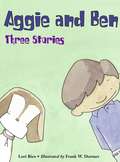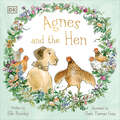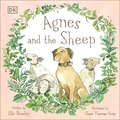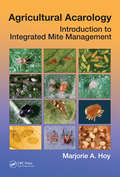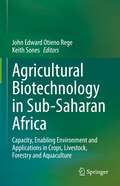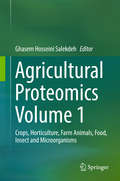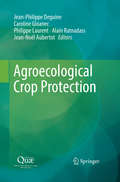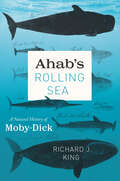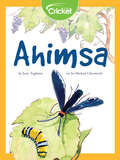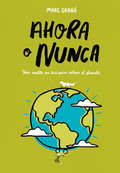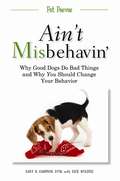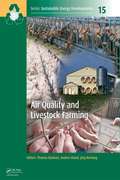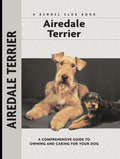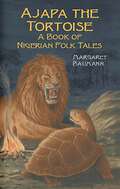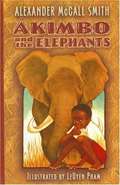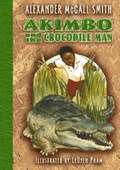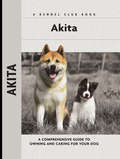- Table View
- List View
Aggie and Ben: Three Stories (Fountas & Pinnell LLI Blue #Level J)
by Lori Ries Frank Dormer<p>A funny and sweet early reader about a new friendship between a boy and his dog. <p>In this first book of the series, Dad surprises Ben with a trip to the pet store. Ben isn’t sure what kind of pet he wants. He knows he doesn’t want a mouse, a snake, or even a cat. But when a certain puppy makes Ben laugh, a lasting friendship is formed. Three short chapters trace a day in the life of Ben and his new puppy, Aggie, as they settle into their new friendship. <p>Dormer's understated illustrations mixed with Ries' easy-to-follow text tells the story of the special bond between a boy and his loyal, loveable dog. Young readers will delight in the continuing adventures of Aggie and Ben.</p>
Aggression
by Kim Campbell Thornton Buck JonesAggressive behavior is the most common problem canine behaviorists encounter. This book answers commonly asked questions about aggressive behavior with helpful tips and easy-to-follow solutions.
Agnes and the Hen (Agnes and Friends )
by Elle RowleyFollow Agnes the dog and Rosie the hen as they head down to the farm in this amusing picture book for children.This lighthearted story tells the tale of Agnes the Great Dane and Rosie the hen with an important underlying message. With Agne&’s help, Rosie discovers that staying true to herself might just be her greatest strength.Agnes and the Hen is an engaging tale for 3-5 year-olds, teaching an important message about how you can avoid following the crowd and embrace your true self. Children will have fun engaging in the bright and beautiful pages of this picture book and following story alongside vibrant illustrations of farm animals.Agnes and the Hen features:- 32 pages of adorable animal illustrations- Easy-to-follow text for little ones to engage with- An amusing storyline that teaches an important lessonThis heartwarming baby book makes the perfect bedtime story, as little ones follow Rosie the hen who likes to be different. Down on the farm the hens do everything together. They peck at their food in perfectly straight lines and sleep in a perfect row in their coop. All except one, that is: Rosie. Parents and children will enjoy following this fun story together, that teaches children to celebrate being different from everyone else. Agnes and the Hen is the perfect addition to an animal lover&’s book collection!At DK, we believe in the power of discovery.So why stop there? If you like Agnes and the Hen, then why not try the other picture book in the series? Agnes and the Sheep is the first book in the collection teaching children an important lesson that the grass isn&’t always greener on the other side.
Agnes and the Sheep
by Elle RowleyFollow Agnes the Great Dane in this charming picture book, who tries to keep three mischievous sheep out of troubleThis entertaining story tells the tale of a Great Dane called Agnes, who is left in charge of the farm and has to keep everything in order. But when three troublesome sheep want to escape the farm, can Agnes stop them? Agnes and the Sheep is an engaging tale for 3-5 year-olds, teaching an important message about how comparing yourself to others won&’t bring happiness. Children can engage in the bright and beautiful pages of this picture book and follow the amusing story alongside vibrant illustrations of farm animals.The heartwarming story of Agnes and the Sheep features:- 32 pages of charming animal illustrations- Easy-to-follow text for little ones to engage with- A real-life experience from Elle Rowley&’s life that inspired the plot- An amusing storyline that teaches an important lesson to little onesThis adorable baby book makes the perfect bedtime story, as little ones follow Fern, Flax, and Baa Baa the sheep who escape the farm to find the brightest, greenest plants they have ever seen…Parents and children can follow this fun story together, that teaches little ones that the grass isn&’t always greener on the other side. Agnes and the Sheep is the perfect addition to an animal lover&’s book collection!
Agnes the Sheep
by William TaylorAn eccentric old lady leaves her large and nasty sheep, Agnes, to Belinda and Joe, setting off a wild and woolly sheep chase. [from the back cover] "Agnes is a real woolly bully. Joe and Belinda made a promise to old Mrs. Carpenter. They promised to take care of Agnes--no matter what. But Agnes isn't your ordinary, everyday sheep. She's Agnes--the attack sheep. So when Agnes wants her bread and milk, she gets it. And when Agnes feels like chasing a neighbor around the yard and butting him over the fence, no one can stop her. But there are people who want to stop her. And even though Joe and Belinda realize that Agnes isn't the nicest sheep in the world, they don't understand why anyone would want to turn her into a sweater and a few lamb chops. So they decide to save Agnes. And to prove that you can teach an old sheep new tricks. Sometimes." Look for Knitwits, another humorous book by William Taylor you will enjoy from the Bookshare collection.
Agricultural Acarology: Introduction to Integrated Mite Management
by Marjorie A. HoyWritten by a globally prominent entomologist, Agricultural Acarology: Introduction to Integrated Mite Management provides tools for developing integrated mite management programs for agriculture, including management of plant-feeding mites, mites attacking bees and livestock, and stored products. Emphasizing the biology, ecology, behavior, and diverse methods of controlling mites, this book provides an overview of the management of agriculturally important mites using all available Integrated Pest Management (IPM) tools, including biological control, cultural practices, host-plant resistance, and pesticides.Agricultural Acarology prepares agricultural managers to identify, manage, and contribute to the field of integrated mite management. An accompanying downloadable resource contains numerous color photographs of mites and the damage they cause, and PDFs of key publications.
Agricultural Biotechnology in Sub-Saharan Africa: Capacity, Enabling Environment and Applications in Crops, Livestock, Forestry and Aquaculture
by John Edward Otieno Rege Keith SonesThis book offers a comprehensive analysis of the application level for various agricultural biotechnologies across Sub-Saharan Africa. The authors examine the capacity available as well as the enabling environment, including policy and investments, for facilitating agricultural biotechnology development and use in the region. For each Sub-Saharan country, the status of biotechnology application is assessed in four major sectors; Crops, Livestock, Forestry and Aquaculture. Examples such as the number and requisite skill levels of trained personnel, biosafety frameworks and public awareness are surfaced in these chapters. This work also discusses the impact of push-pull factors on research, training and food security and identifies opportunities for investment in biotechnology and local agribusiness.Development partners, policy makers, agricultural consultants as well as scientists and private sector investors with an interest in biotechnology initiatives in Sub-Saharan Africa will find this collection an important account to identify key gaps in capacity and policy, as well as priority areas going forward. The volume highlights ways to develop technology and increase agricultural production capacity through international cooperation and inclusive economic growth, making it a valuable practice guide in line with the UN Sustainable Development Goals, in particular SDG 2 Zero Hunger and SDG 8 Decent Work and Economic Growth. Clear case studies round off the reading experience.
Agricultural Implications of Fukushima Nuclear Accident (IV): After 10 Years
by Keitaro Tanoi Tomoko M. NakanishiThis open access book presents the findings from on-site research into radioactive cesium contamination in various agricultural systems affected by the Fukushima Daiichi Nuclear Power Plant accident in March 2011. This fourth volume in the series reports on studies undertaken at contaminated sites such as farmland and forests, focusing on soil, water, mountain, agricultural products, and animals. It also provides additional data collected in the subsequent years to show how the radioactivity levels in agricultural products and their growing environments have changed with time and the route by which radioactive materials entered agricultural products as well as their movement between different components (e.g., soil, water, and trees) within an environmental system (e.g., forests). The book covers various topics, including radioactivity testing of food products; decontamination trials for rice and livestock production; the state of contamination in, trees, mushrooms, and timber; the dynamics of radioactivity distribution in paddy fields and upland forests; damage incurred by the forestry and fishery industries; and the change in consumers’ attitudes. In the series of this book, a real-time radioisotope imaging system has been introduced, a pioneering technique to visualize the movement of cesium in soil and in plants. This is the only book to provide systematic data on the actual change of radioactivity, which is of great value to all researchers who wish to understand the effect of radioactive fallout on agriculture. In addition, it helps the general public better understand radio-contamination issues in the environment. The project is ongoing; the research groups from the Graduate School of Agricultural and Life Sciences of The University of Tokyo continue their work in the field further to evaluate the long-term effects of the Fukushima accident.
Agricultural Proteomics Volume 2: Crops, Horticulture, Farm Animals, Food, Insect and Microorganisms
by Ghasem Hosseini SalekdehThis book will cover several topics to elaborate how proteomics may contribute in our understanding of mechanisms involved in stress adaptation. The knowledge being accumulated by a wide range of proteomics technologies may eventually be utilized in breeding programs to enhance stress tolerance. This book presents comprehensive reviews about responses of crop and farm animals to environmental stresses. Challenges related to stress phenotyping and integration of proteomics and other omics data have also been addressed.
Agroecological Crop Protection
by Jean-Philippe Deguine Caroline Gloanec Philippe Laurent Alain Ratnadass Jean-Noël AubertotThis book is devoted to Agroecological Crop Protection, which is the declension of the principles of agroecology to crop protection. It presents the concepts of this innovative approach, case studies and lessons and generic keys for agroecological transition. The book is intended for a wide audience, including scientists, experimenters, teachers, farmers, students. It represents a new tool, proposing concrete keys of action on the basis of feedbacks validated scientifically. Beyond the examples presented, it is therefore of general scope and proposes recommendations for all temperate and tropical cropping systems. It contributes to the training and teaching modules in this field and it is an updated information support for professionals and a teaching aid for students (agronomy, crop protection, biodiversity management, agroecology).
Ah, Sweet Mystery of Life: The Country Stories of Roald Dahl
by Roald Dahlroald dahl's new book is a wonderful collection of stories, most of which were written in the late 1940s, originally published in various magazines and collections in the forties and fifties, and are gathered here together for the first time. Set in one English village and sharing a cast of characters, these stories--each bearing the inimitable, antic, slightly wicked Dahl touch--have the vivid effect of a novel, giving us the larger picture of this small world in the years just after World War II. And leave it to Dahl to find the most unusual, the eeriest, the funniest, and the most shocking details lurking inside this (or any) pastoral. There's the ratcatcher who looks--and acts--alarmingly like his quarry...the grand backfiring of the greatest pheasant poaching (a "sporting type of stealing") ever almost pulled off...the strange disappearance--and gruesome reappearance--of Ole Jimmy, the elderly, sweet-tempered, tipsy playground attendant...the comings and goings at the illegal greyhound racetrack where the dogs are far tamer than the bookies...the surprisingorigin of the expression "bull's eye" (and a lesson in assuring the sex of your cow's next calf)... Seven stories that delight us with their mixture of the charming and the charmingly perverse, and that remind us--as only a Roald Dahl story can--that the mystery of life isn't always as sweet as it seems.
Ahab's Rolling Sea: A Natural History of "Moby-Dick"
by Richard J. KingAlthough Herman Melville’s Moby-Dick is beloved as one of the most profound and enduring works of American fiction, we rarely consider it a work of nature writing—or even a novel of the sea. Yet Pulitzer Prize–winning author Annie Dillard avers Moby-Dick is the “best book ever written about nature,” and nearly the entirety of the story is set on the waves, with scarcely a whiff of land. In fact, Ishmael’s sea yarn is in conversation with the nature writing of Emerson and Thoreau, and Melville himself did much more than live for a year in a cabin beside a pond. He set sail: to the far remote Pacific Ocean, spending more than three years at sea before writing his masterpiece in 1851. A revelation for Moby-Dick devotees and neophytes alike, Ahab’s Rolling Sea is a chronological journey through the natural history of Melville’s novel. From white whales to whale intelligence, giant squids, barnacles, albatross, and sharks, Richard J. King examines what Melville knew from his own experiences and the sources available to a reader in the mid-1800s, exploring how and why Melville might have twisted what was known to serve his fiction. King then climbs to the crow’s nest, setting Melville in the context of the American perception of the ocean in 1851—at the very start of the Industrial Revolution and just before the publication of On the Origin of Species. King compares Ahab’s and Ishmael’s worldviews to how we see the ocean today: an expanse still immortal and sublime, but also in crisis. And although the concept of stewardship of the sea would have been entirely foreign, if not absurd, to Melville, King argues that Melville’s narrator Ishmael reveals his own tendencies toward what we would now call environmentalism. Featuring a coffer of illustrations and an array of interviews with contemporary scientists, fishers, and whale watch operators, Ahab’s Rolling Sea offers new insight not only into a cherished masterwork and its author but also into our evolving relationship with the briny deep—from whale hunters to climate refugees.
Ahimsa
by Josie TaglienteLily loves all creatures great and small, including spiders, and believes that all lives are precious. When caterpillars begin to destroy the leaves of her beloved grapevine, Lily must figure out how to save her plant without hurting the insects that are eating it.
Ahora o nunca: Una vuelta en bici para salvar el planeta
by Marc GrañóHace diez años, todavía había quien dudaba del cambio climático, las abejas no estaban en peligro de extinción, y reciclar era opcional. Hoy, todo esto es nuestra realidad. #AhoraoNuncaLibro <P><P>Vivimos en un mundo en el que: <br>1.- los grandes bosques... están siendo talados. <br>2.- muchas especies de animales... desaparecen cada año. <br>3.- los veranos son más largos y calurosos..., y los inviernos más cortos y menos fríos. <P>Ahora o nunca nos da una vuelta al mundo para ver la realidad de la Tierra con los ojos abiertos. Aprenderás qué puedes hacer tú, día a día, paso a paso, para salvar el planeta.
Ain't Love Grand!: Earthworms to Elephant Seals (Chicago Shorts)
by Marty CrumpThe natural world is filled with diverse—not to mention quirky and odd—animal behaviors. Consider the male praying mantis that continues to mate after being beheaded; the insects, insects, and birds that offer gifts of food in return for sex; the male hip-pocket frog that carries his own tadpoles; the baby spiders that dine on their mother; or the starfish that sheds an arm or two to escape a predator's grasp. In Ain’t Love Grand, Marty Crump—a tropical field biologist well known for her work with the reproductive behavior of amphibians—examines the bizarre conduct of animals as they mate, parent, feed, defend themselves, and communicate. More importantly, Crump points out that diverse and unrelated animals often share seemingly erratic behaviors—evidence, Crump argues, that these natural histories, though outwardly weird, are actually successful ways of living.
Ain't Misbehavin': Why Good Dogs Do Bad Things and Why You Should Change Your Behavior
by Dvm Dick Wolfsie Gary R. SampsonBarking. Biting. Piddling. Digging. Dogs are wonderful companions, but they can also be challenging housemates. Dr. Gary Sampson has a message for owners: it's not the dog's fault. It's yours. He helps owners understand why their animal is acting - or reacting - in a certain way and explains how to change that behavior for the better. Using real-life examples from his practice, Sampson proves it's possible to convert that howling devil into an angel.
Air Quality and Livestock Farming (Sustainable Energy Developments)
by Thomas Banhazi Andres Aland Jörg HartungAir quality has a direct influence on health, welfare and production performance of livestock as the high concentrations of noxious gases, dust and airborne microorganisms are likely to reduce production efficiency and the general welfare of farm animals. Long term exposure to particulates in livestock buildings might also affect the respiratory health of farm workers. Dust in animal buildings contains many biologically active substances such as bacteria, fungi, endotoxins and residues of antibiotics (as a result of veterinary treatments) that are suspected to be hazardous to human health. Furthermore, air pollutants emitted from livestock buildings can reduce air, water and soil quality and can potentially undermine the health of nearby residents. Airborne emissions include ammonia, methane, nitrous oxide, particulates like dust and microorganisms. In addition, other potentially harmful substances such as heavy metals, antibiotic residues and components of disinfectants might be also emitted from livestock building that are potentially damaging to ecosystems. In this book, key aspects of agricultural air quality, such as monitoring, managing and reducing airborne pollutants in and around livestock facilities are reviewed. Features: addressing the raising awareness of the importance of optimal health and welfare for lifestock species with contributions from international specialists and researchers providing up-to-date information for professionals involved in modern animal producti This book will be useful for farming professionals, academics, students, policy makers, business leaders, regulatory bodies and agricultural consultants.
Airedale Terrier
by Bardi MclennanThis Comprehensive Owner's Guide to the Airedale Terrier serves as a complete introduction to the breed known to his admirers as "the king of terriers." The largest of the British terriers, the Airedale, hailing from that industrial town in northeastern England, has been favored as a working terrier, show dog, military messenger dog, and farm dog since the nineteenth century. The book begins with an entertaining chapter on the breed's history in England followed by chapters on characteristics and the breed standard encapsulating all of the virtues of this imposing terrier breed, offering sound advice about which owners are best suited to the breed.New owners will welcome the well-prepared chapter on finding a breeder and selecting a healthy, sound puppy. Chapters on puppy-proofing the home and yard, purchasing the right supplies for the puppy as well as house-training, feeding, and grooming are illustrated with handsome adults and puppies bursting with energy and personality! In all, there are over 135 photographs in this compact, useful, and reliable volume. The author's advice on obedience training the super smart Airedale will help readers better mold and train their dogs into the most socialized, well-mannered dog in the neighborhood. The extensive chapter on healthcare written by Dr. Lowell Ackerman provides up-to-date detailed information on selecting a qualified veterinarian, vaccinations, parasites, infectious diseases, and more. Sidebars throughout the text offer helpful hints, covering topics as diverse as historical kennels, toxic plants, first aid, crate training, carsickness, fussy eaters, and parasite control. Fully indexed.
Ajapa the Tortoise: A Book of Nigerian Folk Tales
by Margaret BaumannLong before people could turn to books for instruction and amusement, they relied upon storytellers for answers to their questions about life. Africa boasts a particularly rich oral tradition, in which the griot -- village historian -- preserved and passed along cultural beliefs and experiences from one generation to the next. This collection of 30 timeless fables comes from the storytellers of Nigeria, whose memorable narratives tell of promises kept and broken, virtue rewarded, and treachery punished.Ajapa the Tortoise -- a trickster, or animal with human qualities -- makes frequent appearances among the colorful cast of talking animals. In "Tortoise Goes Wooing," he learns a valuable lesson in friendship and sharing. Ajapa's further adventures describe how, among other things, he became a chief, acquired all of the world's wisdom, saved the king, tricked the lion, and came to be bald. Recounted in simple but evocative language, these ancient tales continue to enchant readers and listeners of all ages.
Akbar Birbal Tales
by BPI India Pvt LtdAkbar-Birbal tales are passed on mainly by oral tradition. They focus on how Birbal manages to outsmart the envious courtiers who try to trap and portray him in poor light in front of Emperor Akbar, often in a humorous manner with him shown giving sharp and intelligent responses.
Akiak A Tale of the Iditarod
by Robert J. BlakeFrom the Book Jacket: It is Iditarod day. Fifty-six dog teams will race through 1,151 miles of rugged Alaskan terrain from Anchorage to Nome. Akiak knows these miles well. As lead dog, she has raced the incredible trail before, but never won. She is ten years old: if she is going to win, it must be now. When snow hurts her paw on the fourth day out, Mick, her musher, must leave her behind and continue the race without her. The rules say once a dog is dropped from the race, it may not rejoin the team. But Akiak doesn't know about rules. She is a lead dog, and her place is with the team. Nothing, not blizzards, not breaking ice, not the people out to catch her, will stop Akiak from catching up to her team. The question is, can the team still win? Robert J. Blake's majestic snow-scapes will lead you through this unforgettable tale of a dog with a hero's heart, a dog who will not give up. Akiak will leave you cheering.
Akimbo And The Elephants
by Alexander Mccall SmithTen-year-old Akimbo lives on a game preserve in Africa. His father is the head ranger, and Akimbo is eager to help him whenever he can--even if it means getting into some pretty dangerous situations. In Akimbo and the Elephants, ivory poachers are killing grown elephants for their tusks and leaving the calves to die. When the authorities fail to turn up new leads, Akimbo sets out to save the elephants by posing as a hunter himself.
Akimbo and the Crocodile Man
by Alexander Mccall SmithWhen a visiting croc expert invites Akimbo along on a field study, Akimbo is thrilled. But when the crocodiles attack the guide, injuring him gravely, it will be up to Akimbo to cross a crocodile-infested river and jump start a truck to bring back help. A rousing new Akimbo adventure from bestselling author Alexander McCall Smith. Ages 7 to 9.
Akita
by Barbara J. Andrews Meg Purnell Carpenter Meg Purnell-CarpenterThis Comprehensive Owner's Guide to the Akita serves as a complete introduction to the largest of Japan's spitz breeds. Hailing from "Land of the Rising Sun," the Akita is a official recognized as a Natural Monument in Japan and regarded by Westerners as a dignified and courageous guardian breed. Written by two of the most influential Akita breeders in the world, Barbara J. ("BJ") Andrews of O'BJ kennels and Meg Purnell-Carpenter of Overhill kennels (UK), the book begins with a fascinating and informative chapter on the breed's history in Japan, tracing its development in the U.S. and England a historical path that both authors were instrumental in achieving. The authors continue with chapters on the breed's characteristics and the standard, encapsulating all of the virtues of this handsome, dominant and loyal breed, offering sound advice about which owners are best suited to the breed.New owners will welcome the well-prepared chapter on finding a breeder and selecting a healthy, sound puppy. Chapters on puppy-proofing the home and yard, purchasing the right supplies for the puppy as well as house-training, feeding, and grooming are illustrated with handsome adults and puppies bursting with attitude and personality! In all, there are over 135 photographs in this compact, useful, and reliable volume. The author's advice on obedience training the strong-minded and strong-bodied Akita will help readers better mold and train their dogs into the most socialized, well-mannered dog in the neighborhood. The extensive chapter on healthcare provides up-to-date detailed information on selecting a qualified veterinarian, vaccinations, parasites, infectious diseases, and more. Sidebars throughout the text offer helpful hints, covering topics as diverse as historical kennels, toxic plants, first aid, crate training, carsickness, fussy eaters, and parasite control. Fully indexed.
